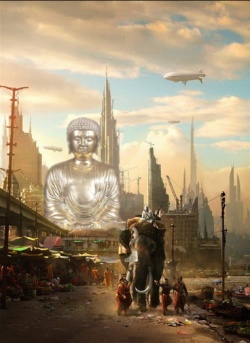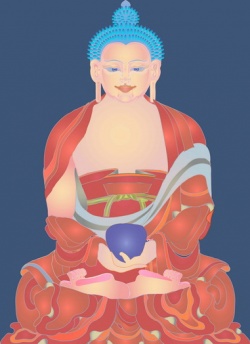Learning Buddhism starts with taking refuge in the Three Treasures
Many people share a common opinion that it suffices for a person to have a good heart and therefore there is no need to take refuge in the Three Treasures (Buddha, Dharma and Sangha). However, do they know the true extent of their goodness?
Even if a person’s heart (mind) and his actions are so virtuous that they are reborn in the realm of heavens, and for that matter in the highest levels of the heavens which is the heaven of “non-thinking and non-non-thinking” (Naivasamjnanasamjnayatana), although there is no form (body), there is still mind-consciousness. If in this mind-consciousness there is a seed of killing which was previously planted in the mind-consciousness, that seed may still emerge and cause the person to descend to hell.
Therefore, people have to form an affinity with the Three Treasures: the Buddha, the Dharma and the Sangha, and be illumined by the brightness of the Buddha so that they can be liberated. Such an affinity is formed by taking refuge in the Three Treasures and thereafter cultivate diligently.
The Buddha, Dharma and Sangha are the rarest and most invaluable treasures in the world. They are different from the worldly treasures, for they could not be bought nor can they be exchanged with whatever worldly materials. However, people can resonate with the Three Treasures through their faith and sincerity.
The Three Treasures of Buddha, Dharma and Sangha in Buddhism are further broken down into different perspectives. The “Sustained Three Treasures” refer to the Three Treasures that live on and sustain the Buddhism that exists in this world so as to spread and pass on to the later generations. These include the images of the Buddha which may be made of stone, clay, wood, metal, or drawings, referred to as the Buddha Treasure; the Tripitaka, the records of the teachings of the Buddha, are referred to as the Dharma Treasure. Ordained monks and nuns (bhiksu and bhiksuni) who renounced the world to cultivate and create conditions for others to practise the Buddhist path, promote the teachings of the Buddha and benefit sentient beings, and thereby continuing the wisdom-life of Buddha, are referred to as the Sangha Treasure. These are the Sustained Three Treasures.
The “Own-nature Three Treasures” refer to three attributes that everybody has. Every human being has the same pure awareness-nature as the Buddha. This is called the Treasure of Own-nature Buddha. When unorthodox or wrong thinking does not arise in our mind, and we hold right understanding and right views, then that is Treasure of Own-nature Dharma. When we learn the teachings of the Buddha and put them into practise thereby illumining our own pure brightness, that is the Treasure of Own-nature Sangha. These are the Three Treasures of Own-nature and are inspired only through the sincerity in taking refuge in the Three Treasures and cultivating according to the teachings. People should not set unrealistic goals and make casual remarks that they possess the Own-nature Three Treasures, and thus there is no need to take refuge in the Three Treasures. Such talk is sowing the seeds for hell.
The objective of taking refuge in the Three Treasures is to learn from them. Therefore, people who aspire to learn from the Buddha have to take refuge in the Three Treasures. As an illustration, a person who is studying in a certain university cannot simply say that he merely wants to pursue his studies and there is no need to bother with the enrolment. But, to obtain a recognized university qualification requires enrolment in the university, registration for examinations, diligence in the studies before one can graduate with a degree from the university. However, if a person is not enrolled in the university but he completed the course books through self-study at home, he is not recognized as having graduated from the university.
Hence, a Buddhist has to take refuge in the Three Treasures, learn the teachings of the Buddha and put them into practice. Only then may he be called an authentic practitioner of Buddhism. On the other hand, there are many people who believe in the teachings of Buddhism but they have not yet taken refuge in the Three Treasures. We cannot say that they are not Buddhists. Instead, they are better described as would-be Buddhists because they will take refuge in the Three Treasures in the future.
As Buddhists, after we have taken refuge in the Three Treasures, we still need to constantly take refuge in the “”Own-nature Three Treasures” too. When our mind resonates with the Three Treasures, we will illumine our wisdom and brightness. We will constantly be with Buddha. This is the significance of taking refuge in the Three Treasures.

